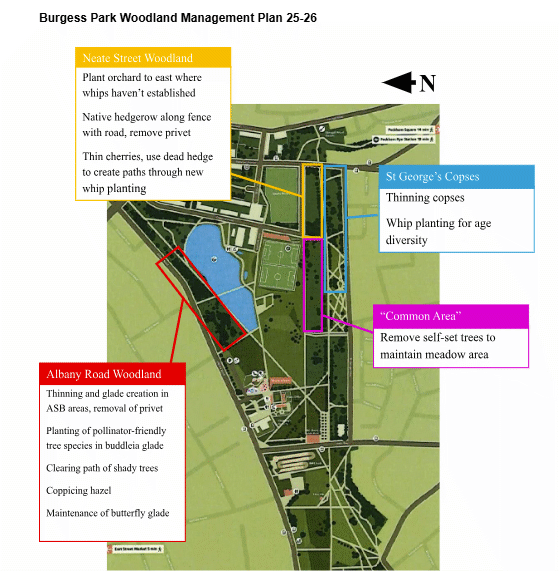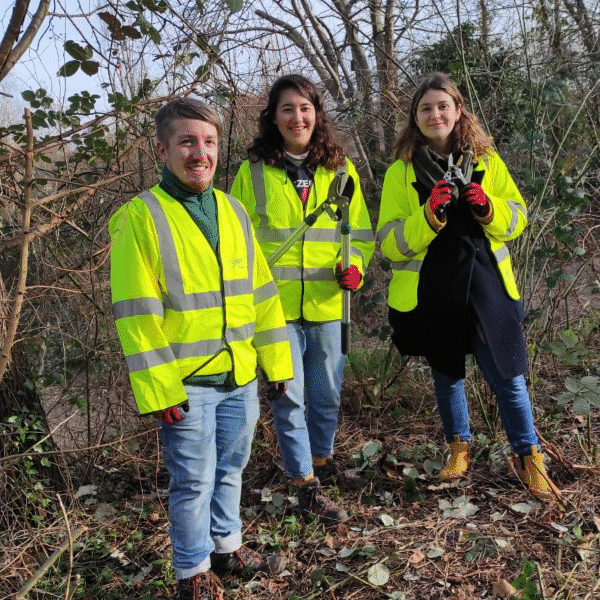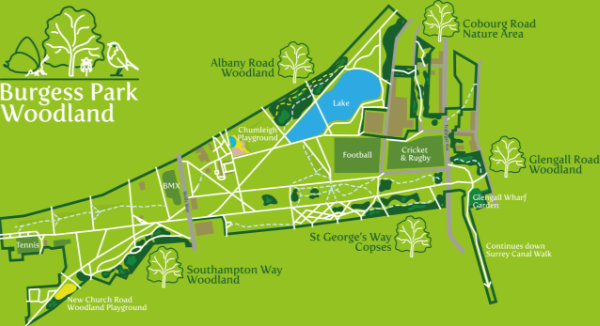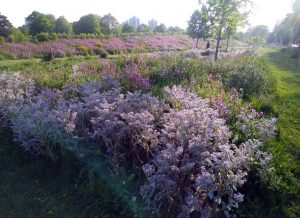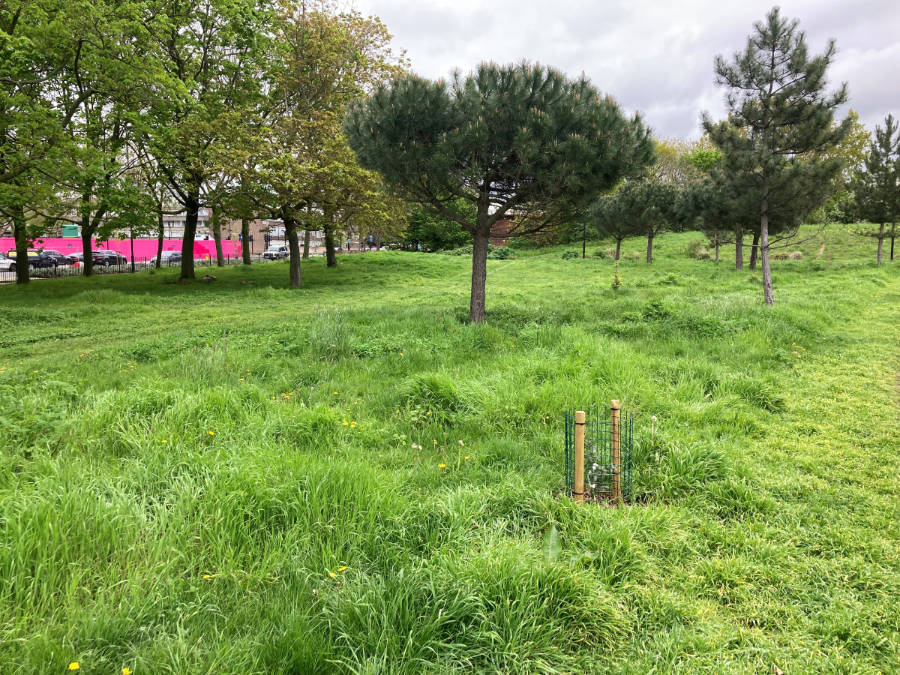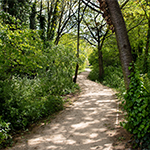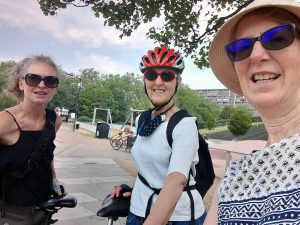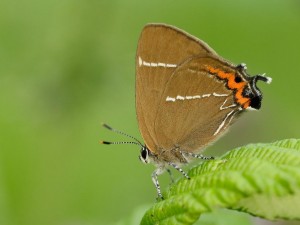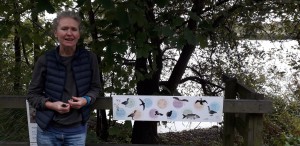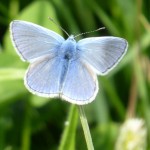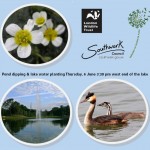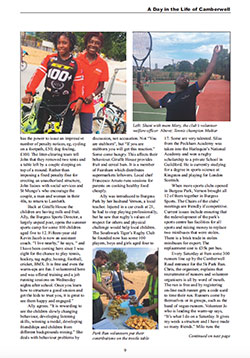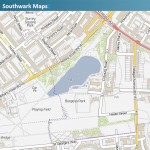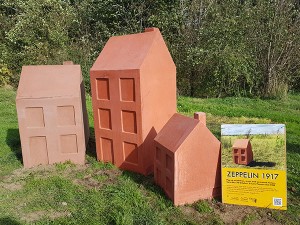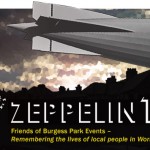Playground for under 5s refurbishment
There is funding to update the playground for the under 5s next to Chumleigh Gardens and directly outside the Stomping Grounds Café. It currently has several pieces of equipment for younger children including a sand pit.
The Southwark Council leisure team want to make play more inclusive and accessible for those with additional needs. To help shape the final design complete the survey or share it with anyone who may be interested by 10 December 2025.
The preferred design will be posted on the consultation hub for feedback and on boards around the site. Email leisureprojects@southwark.gov.uk to join the mailing list and get project updates.
Major events licence for summer 2026?
Southwark Council’s Events Team has received an application from event organisers We Are The Fair on behalf of Elixar Events Ltd, to hold major-scale events in Burgess Park in July/August 2026. The Events Team has launched a consultation on whether to grant a licence. Access the consultation survey here. The closing date is Friday 19 December 2025. The proposal is for music events: Boiler Room, Jazz Café, Burgess Park Community Day, Maiden Voyage and Eastern Electrics 2026. Please see below for the some of the problems caused by the 2025 music events.
The current proposal is to cover the same space in Burgess Park East as the 2025 events for three weeks from the 25 July (fencing goes up) to the 14 August (fencing etc removed). There will be 6 ‘live’ days of music.
There will be community engagement sessions on Thursday 4 December 2025. These sessions will enable people to learn more about plans for the event directly from the event operators. The sessions will be held online and at a venue local to the park. If you are interested in attending, please contact:
events@southwark.gov.uk or telephone 020 7525 3422.
Burgess Park woodlands management
Wednesday 19 November 2025, 10am – 3.00pm
Book via London Wildlife Trust’s volunteering platform for the next opportunity to volunteer. Register here.
Join Tom Brodie the new Woodland Nature Recovery Officer and the Friends of Burgess Park for practical workdays over the winter including woodland thinning and coppicing, glade maintenance, dead-hedging, butterfly transects and bat surveys. Find out more and register to volunteer.
Southwark Parks department are working with London Wildlife Trust to develop woodland management and volunteering.
Despite its industrial past and heavy footfall, Burgess Park has become a tapestry of habitats and an island of biodiversity in a densely populated part of London. The woodland areas are in need of more management as valuable habitats for birds, bats, pollinators and invertebrates.
Have a look at Tom Brodie’s plans for Burgess Park.
Consultation with the organisers of August’s large music events in Burgess Park
Wednesday, 15 October
Meeting at 1st Place Family Hub, 12 Chumleigh Street London, SE5 0RN in Burgess Park
RSVP to Kat at: wearethefair@thecolumbogroup.com
The organisers have set up a survey to get feedback on the events they have hosted. They want to know what worked and what needs improvement. Access the survey here.
The Southwark events team were worried by the state of the park after the events and wrote that “the lawn was significantly impacted in high footfall areas. … While these festivals have brought many benefits to the local area, we recognise the importance of maintaining the park’s natural environment for all to enjoy. We want to reassure you that plans for restoration works are being developed and will be soon underway. The event operator and the council’s parks team are assessing the affected areas and will be agreeing and implementing a full programme of lawn restoration. In addition to these immediate measures, we are also developing longer-term strategies to enhance the resilience and quality of the park’s lawns in this area.”
The Friends of Burgess Park were very concerned by the state of the park and responded to the events team:
Dear Events Team
Thank you for your email confirming that remediation is needed for the appalling state of the grass following the large events over two week-ends in August. A huge area of Burgess Park is completely unusable for the rest of August during the summer holidays and potentially longer. [A] dust bowl [was] left behind after the event. The size and scale of the commercial events this year is too big; too much of the park is fenced off, the increased size of the crowd creates too much damage to the ground and grass.
We await more information on restoring Burgess Park great lawn area and longer term strategies that recognise the fragility of this area of the park which has been re-landscaped and then required new drainage all within the last c. 10 years.
Hot plates
Southwark Council created a questionnaire to find out whether you wanted to increase the number of hotplates in Burgess Park (the questionnaire was open until 3 September 2025). More information about the scheme is available to read here.
90th birthday visit to Burgess Park
Former Park Manager David Sadler MBE had a surprise birthday visit to the park to celebrate his 90th birthday. He was welcomed by members of Friends of Burgess Park and the current park manager and head gardener. It was a wonderful day as Dave reminisced about the early days of establishing the park including clearing bombs and the hazard of shrapnel in trees. You can read about the visit here.
Music events in the park
Southwark Council explains why they hold ticketed events in parks here.
Community litter picks
Saturday July 26, Cobourg Road Nature Area
hosted with 1st Place, 10:30 am to 12
Saturday August 2 and Sunday August 3, meet by the Hot Plates Area,
a clean-up action day and more are planned
hosted with LA Family UK
10 am to 6 pm
Saturday August 9, meet by the Tennis Cafe
hosted with parkrun
9 am to 10 am
Friday August 15, meet by the Angling Kiosk
hosted with Angling Club and local residents
5 pm to 6 pm
If you know a group interested in hosting a park litter pick with us please get in touch, email friendsofburgesspark@gmail.com
Demolishing Giraffe House
Southwark hosted a drop-in session to answer any questions you may have about why the Giraffe House is being demolished. It was held outside the Giraffe House at 285 Albany Road on Saturday 26 July 2025. More information can be read here from Southwark Council about the decision and plans for a new clubhouse for the BMX track.
Saturday art workshops
A series of free, nature-inspired, intergenerational, art workshops are being held at the Art in the Park studio in Burgess Park on Saturdays 2-4pm until 25 October.
There will be two art activities at each session suitable for both adults and children. The activities will vary including printing, drawing, weaving, textiles etc.
Indoor and outdoor space will be used as available and refreshments will be provided.
Drop in sessions, no need to book. All welcome!
Art in the Park, Chumleigh Street, SE5 0RJ
Food growing at Chumleigh Gardens poly tunnels
Glengall Wharf Garden is running a new community plant growing project at Chumleigh Gardens. This will support community growing projects, register your interest:
- Burgess Park Community Plant Nursery will be giving out a first round of young vegetable plants to community growers! More here.
- Opportunities to attend hands-on weekly volunteer workshops. More here.
Counting birds in the park
Dave Clark and other Burgess Park recorders have recorded four years of year-long data for the birds in the park. You can see all the information and pictures in Dave’s post.
You can also find out how to get involved in recording bird sightings in Burgess Park. Dave points out that our knowledge is dependent on enthusiastic amateurs.
Greg Smith’s meadow blog
The third instalment of the blog by Greg Smith, Burgess Park’s head gardener is now online.
Very sadly, Greg died at the beginning of December. We, the Friends of Burgess Park, will miss him very much. He was a great friend to the Friends.
In his blog, he has extended his research into the care and improvement of the park’s meadows, in particular the wild flora. Many of Greg’s photos are included.
As well as documenting his own experience, he was keen to develop the meadows in the future and encouraged us all to appreciate and take care of our environment.
Woodlands maintenance
Friday 6 December 2024, 10 – 11:30 am
Albany Road woodlands
Our first event was in Albany Road woodlands clearing bramble and buddleia from a site which was reseeded earlier this year for a glade and wild flower meadow. This was a project with Big City Butterflies to support Burgess Park butterflies.
The session was led by Liam Nash, Southwark Council ecologist.
More woodland maintenance activity for early 2025 will follow.
FOBP ecology
The AGM was held on Tuesday 5 November 2024. at 1st Place Nursery, Chumleigh Gardens
Liam Nash the borough ecologist spoke about the ecology of Burgess Park. Liam’s presentation can be seen here. He discussed possible plans for the park regarding the woodlands, freshwater, meadows and scrub.
Southwark Cycle Fest
in Burgess Park next to the BMX track
was held on Sunday, 29th September 2024
This event was led by Southwark Council to showcase the cycling initiatives available across the borough. This is part of Southwark’s Streets for People strategy: the Council’s plans to improve walking, wheeling and cycling.
- JoyRiders led rides—t
- Community Cycle Works Bike Fix will check bikes for free
- Peddle My Wheels Bike Market, OurBike: browse affordable second-hand bikes or take advantage of free 3 month bike hire
- Cargo bikes and Try Before You Bike vouchers
- BetterPoints app—earn points through active travel
- The Met Police offered free bike marking and security advice; activities for the children
- St John’s Ambulance First Aid interactive activities
- Public Health Bus—information and support with a range of free health checks.
Friends of Burgess Park were there to discuss cycling around the park.
Woodlands trail
We have updated the signage for the Friends of Burgess Park Woodland Trail. Most of the signs are in but a few more will go in soon.
Many thanks to James Gribble for the design and production of the signs.
Southwark News reported on the development of the trail which was created by local volunteers.
The route leads walkers through patches of wild carrot, plum trees, sometimes clouds of speckled butterflies, hidden fox burrows and much more.
Look out for our wooden woodland markers throughout Burgess Park and follow them on the trail through the woodlands.
Scan the QR codes on each with the camera on your smartphone and find out interesting facts about the woodlands and the history of the area.
You will even find a different animal on each sign – the QR code will show you a short fact about the animal you have found!
The Friends of Burgess Park hope the path will promote the park as a place for exploration and connection with nature.
FOBP will be running a woodland winter maintenance activity soon.
Healthy woodlands survey
Saturday 26th March 2024
Friends of Burgess Park hosted an event in Burgess Park led by Alastair McKinlay from TCV (The Conservation Volunteers) on assessing woodland condition.
This was a practical hands-on session using the newly-developed assessment template developed by TCV and London Wildlife for London-wide work on woodlands.
Birdwatching in Burgess Park
A hugely enjoyable guided walk took place on 27 Jan 2024 when 39 species were seen or heard on a stroll around a variety of habitats. The loud, distinctive call of a Cetti’s Warbler, a Song Thrush singing beautifully and a sighting of a Greenfinch were some of the highlights.
The annual RSPB (Royal Society for the Protection of Birds) Central London Local Group’s January walk in Burgess Park was led by two of its members, Dave Clark and Czech Conroy, and was co-organised with the Friends of Burgess Park. Read the fascinating blog by Czech Conroy and Alison Gibson describing the discoveries on the walk with great pictures by Laura Kor and the list of bird species compiled by Tom Rogers.
Burgess Park woodlands activities winter/spring 2024
Butterfly habitat management project in the Albany Road woodlands
On Saturday 27 Jan 2024, our woodlands maintenance volunteers were clearing brambles and coppicing to enhance the glade in the Albany Road woodlands. This was the first phase of the works organised by Southwark Council.
The second phase will be run by Big City Butterfly Project who will employ a contractor to de-turf, remove roots and sow the area with a meadow mix within the glade FOBP are creating.
This is part of the Friends of Burgess Park healthy woodlands project. We have also been awarded funding from the Southwark Council Cleaner Greener Safer fund for a new pathway. Read more about the woodlands in Burgess Park.
Flowering meadow
The Head Gardener of Burgess Park, Gregory Smith and his team have been developing a flowering meadow along Albany Road. His latest blog describes sowing seed in the area and what has resulted. “We can introduce a wider range of wild native plants by sowing seed, but often nature knows best and will try to find its own natural balance of plants over time … so then our job is to gently adjust this balance so it remains suitable for a busy park.”
To mow or not to mow
Gregory Smith, Head Gardener of Burgess Park has written about being a gardener and an environmentalist. He is concerned with what grows naturally, as well as which human-planted or sown, native or non-native plants can be added in order to create more diversity, food sources and habitat for wildlife. With a multi-layered approach to grass cutting, all kinds of wild plants can appear and lawns can become useful habitats. These will link all the intentional planting in the park to create a more complete ecology. Find out more about what the gardeners have been doing and experimenting with by reading his blog on making meadows.

Follow this link to read more about the Grand Surrey Canal on the Friends of Burgess Park heritage website: Bridge to Nowhere. Recently, Southwark News featured comments from our heritage website in their article about the canal before it was filled in in the 1970s and the traces of it that are still left.
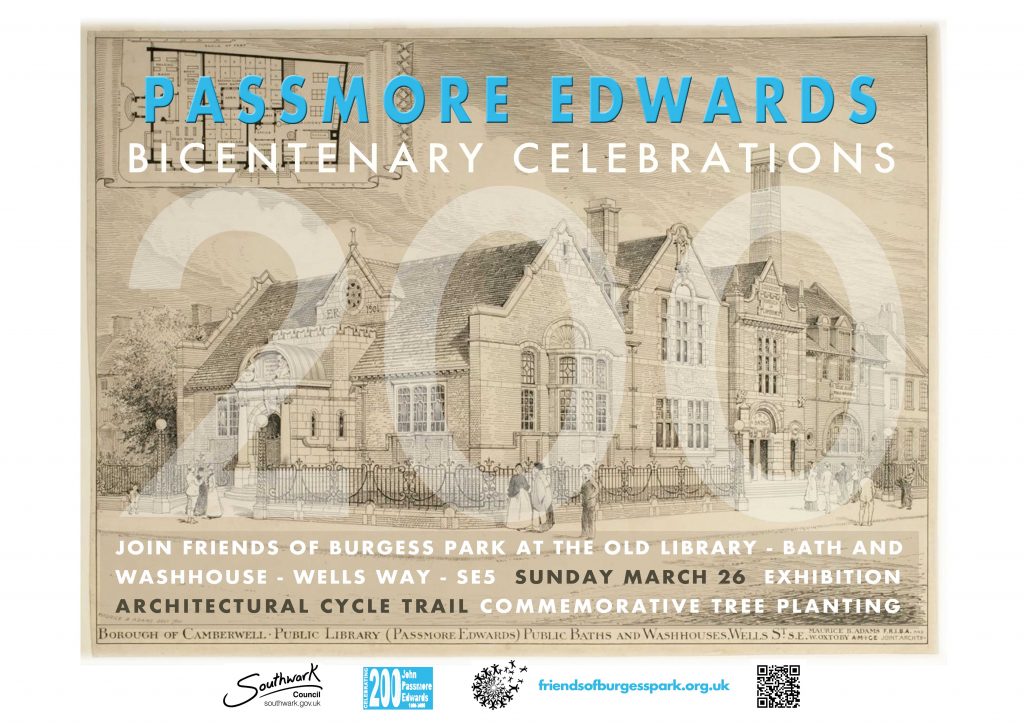
Celebration 26 March 2023
Passmore Edwards bicentenary
Celebrate the Grade II listed building and its benefactor Passmore Edwards
This year marks the 200th anniversary of Passmore Edwards’ birth on 24th March 1823 and Friends of Burgess Park are joining with others around the UK to celebrate the Passmore Edwards 200 Festival. We’ll be holding a programme of events based at the old library, baths and washhouse on Wells Way on Sunday 26th March. There’s an exhibition about the man and his legacy, children’s activities, a commemorative tree-planting, a reading by local author Jacqueline Crooks from her new book, refreshments and more.
Bike Tour 2–4pm We’ve also organised a short Bike Tour around three of Passmore Edwards’ south London buildings, guided by a renowned local architect. You can book now for the bike tour 2pm to 4pm on Eventbrite – places are limited to 25, so book early!
Commemorative Tree Planting 4.00–4.30pm Across the country Rowan trees are being planted to celebrate the Passmore Edwards bicentenary. Join us from 4pm for the tree planting and reading by local author Jacqueline Crooks from her new book Fire Rush, and refreshments.
Exhibition 1–5.30pm – Find out more about Passmore Edwards with an exhibition on loan from the Passmore Edwards legacy. Plus more about the old library bath and washhouse building, its history and future role, benefitting local people.
Read more about Passmore Edwards and the library on the Bridge to Nowhere Friends of Burgess Park heritage website.
More about the Passmore Edwards celebration in Burgess Park on the Southwark News website.
The Woodland project
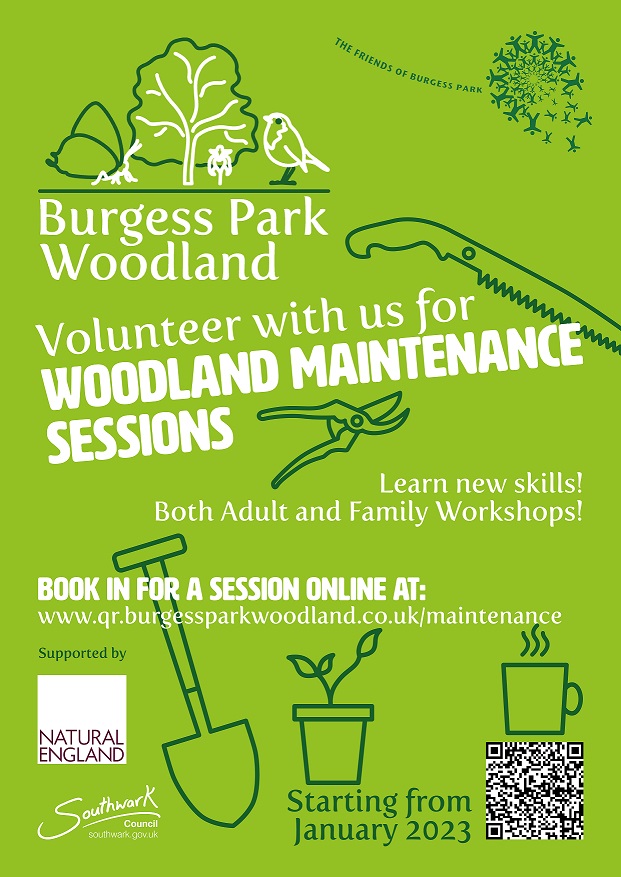
Friends of Burgess Park held a 12 day long festival to launch the Burgess Park Woodland in 2023, a project aiming to improve our woodland through better management and community engagement.
On Saturday 26 September the festival launched with the Albany woodlands pop-up walk and family woodland arts at Chumleigh Gardens playground.
Tackling litter
Michael Faraday primary school art work for anti-litter banners
Thank you Year 3 pupils (summer 2022) and for helping litterpic. See the banners in Albany Road near Giraffe House and Wells Way near the old library.
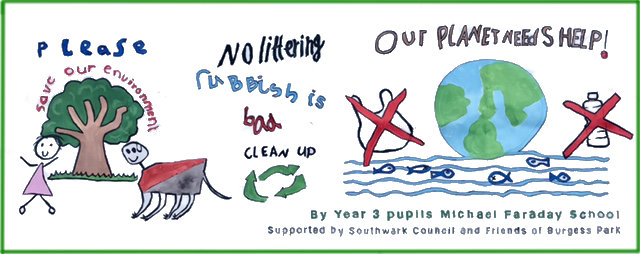
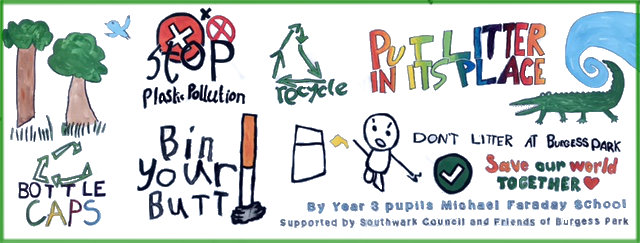
FOBP weekly litterpic every Monday morning 8am to 9am
FOBP provide litterpicks, gloves and bags.
Meet at Chumleigh Gardens – in the gardens behind the behind the cafe.
Woodlands wildlife
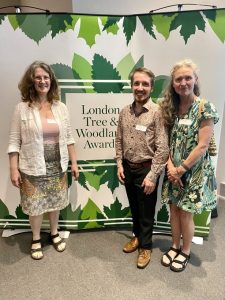
Highly Commended Our woodlands campaign to protect Southampton Way woodlands against development pressure was highly commended with a London Urban Forest Award at the London Tree and Woodland Awards 2022. Thanks to all local groups and park users who have supported us.
The Awards ( #TreeOscars) are organised by the Forestry Commission and supported by the Mayor of London. They aim to raise the profile of London’s trees and woodlands and their need for active management. The awards showcase the work taking place all over the city to protect and increase London’s urban forest (urban forestry guidance).
Southwark Civic Awards for FOBP:
Mayor’s Discretionary Award 2022
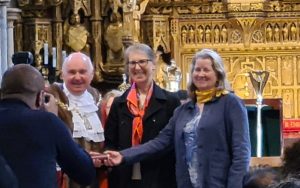
Thank you Southwark Mayor Cllr Barrie Hargrove for the 2022 Discretionary Award for Friends of Burgess Park’s “ongoing and successful commitment … thinking of the park’s welfare first and foremost” presented at Southwark Cathedral.
Massive thanks to all our volunteers, past, present, and more importantly, future ones. Join us!
Find out more about events in Burgess Park.
Congratulations to Kye Whyte at Peckham BMX
Kye Whyte won a siver medal at the Tokyo Olympics. Many congratulations to him, his family and Peckham BMX Club.
The Peckham Club started at the Bird-in-Bush park track and then moved to the Burgess Park track.
Find out about riding at the Burgess Park track.
Information about the Peckham Challengers BMX Club.
Help protect the woodland in Burgess Park
Burgess Park’s woodlands are vital for local wildlife and they are a precious resource in an urban area. Current plans for tall buildings on the edge of the woodlands will reduce the sunlight and change the habitat.
To understand what impact tall buildings would have, we need an independent wildlife report to present to Southwark’s Planning Committee. The goal is to raise £1500 by the end of May 2021 to commission an ecology report from the London Wildlife Trust. Find out more and make a Crowdfunder contribution here.
Read the blog about the importance of light for the Burgess Park woodlands.
Annual bird count from your home
Unable to run our usual annual bird count in the park due to current restrictions, we explain how you can still get involved from home with the RSPB survey, as well as identify bird songs, and take a soundscape walk around the park. Find out more.
Sign the petition to stop building in Burgess Park
The Southampton Way entrance to Burgess Park has an area of derelict land used for what was supposed to be temporary scrap yards and car washing.
The land has been designated as part of the protected Metropolitan Open Land of Burgess Park for over 30 years as the council steadily CPO’d (Compulsory Purchased) the various bits of privately owned land selected to be a park in the original Abercrombie Plan after WW2.
However, a developer has bought an option on the site and is suggesting that a 6-storey residential tower-block be built on designated park land.
It is crucial that this land which has been blighted for so long, be landscaped and included in the park next to the recently improved wildlife site.
Please sign the petition calling on Southwark Council to oppose any planning application for building on this site and call on them instead to fulfill their promise to CPO and incorporate this piece of the Burgess Park jigsaw.
Park art tour
Take a walk, virtual or real, around Burgess Park to view artworks that have been placed here over the years. The Park Art map can be found on the Friends of Burgess Park’s Bridge to Nowhere heritage website which investigates the history of the park that emerged from the streets of south London.
Gulls on the lake
Take a look at the lake during the winter when the number of gulls and cormorants increases. Identify four different kinds of Gull.
Urban games and skate bowl consultations
The concrete skate bowl will take over a section of the park next to the BMX track and unfortunately an estimated 3,000 square meters of grass will be lost due to its construction. Friends of Burgess Park object to the replacement of a green area with concrete, one of the worst producers of CO2 . This is the narrowest part of the park, which has been traversed with paths and cycle routes, with tall buildings planned to the north and possibly south, pouring concrete all over it is not an improvement. It is in fact turning this green area into an urban environment not a refuge from it.
Have you had your say on the Southwark Council
Streetspace plan yet?
Some ideas are already being implemented and Friends of Burgess Park were out looking at opportunities to improve active travel around the park.
We are promoting the Burgess Park Orbital, a protected route, to take cyclists who want to travel securely and efficiently around the park through the neighbourhood so they don’t have to cross the park. The park is very busy at the moment with people socialising and exercising. Some cyclists simply want a straightforward way to get to the other side without interfering in park activities. Some want another place to exercise. Some want an alternative to cycling through the park in the dark winter months.
Using routes around the perimeter means that there will be adequate street lighting rather than trying to light the park and contributing to light pollution which must be controlled according to the National Policy Planning Framework (NPPF).
Click the links below and give each a thumbs up, bottom right.
Let’s show support to get these improvements.
Burgess Park Orbital
1. Cycle lanes around Burgess Park using street lighting.
Albany Road
2. Cycle lanes at Albany Road and the Old Kent Road.
3. 2-way protected cycle route the full length of Albany Road.
Albany Road and Portland Street
4. Adapt the cycle crossing from Portland Street into Albany Road to 2-way and on to Wells Way.
New Church Road/Southampton Way
5. Reinstate the existing cycle route by the new playground from Kitson Rd and continue it down Southampton Way.
Wells Way
6. Wells Way cycle lane and widen pavements.
7. Wells Way underpass for pedestrians and St George’s Way junction.
8. Provide cycle parking at the Old Library instead of car parking.
9. Pavements too narrow at junction of Wells Way and St George’s Way
Parkhouse Street/Wells Way
10. 2-way cycle routes on Parkhouse Street.
Burgess Park West
11. Burgess Park West.
St. George’s Way
12. Remove cars on St George’s Way and green route for cycling.
13. Provide cycle lanes which use street lighting for safe winter cycling.
Surrey Canal
14. Surrey Canal too narrow; promote Sumner Road cycle lane alternative
15. Peckham Square for pedestrians; promote Sumner Road cycle lane alternative
Litter-free Mondays and Thursdays July – September
Weekly litter pick Mondays 7:30-9.30am and Thursdays 6:15-8pm July to September 2020. Meet at the picnic benches at Chumleigh Gardens. Gloves and litter pickers provided or bring your own.
More information here.
Read the blog.
Launch of Southwark nature action conservation volunteers
Dave Clark provided online training in recognising birdsong. He has an MSc in Ornithology from Birmingham University and is particularly interested in the interaction between birds and humans. Read his blog about birds in Burgess Park From Africa to the Old Kent Road and follow him on Twitter @daveclark77.
Burgess Park contains a mosaic of locally important habitats including areas of rough grass, wildflower ‘meadows’, hedges and patches of bushes, scrub and trees; and a lake and some small ponds with reeds.
Regular visitors include House Martins, Swifts, Blackcaps, Reed Warblers and Whitethroats. Other birds include House Sparrow, Starling, Greenfinch, and typical garden species like the Robin and Blue Tit. The lake has several different species of waterbirds, including three species of geese – Canada, Egyptian and Greylag.
Tuesday 3 March 2020, 7pm, Theatre Deli, Wells Way SE5 Book ticket.
Help with species’ habitats and nature conservation in Southwark parks: carry out surveys, help with planting, dig ponds, map wildlife sightings to target habitat action, photograph wildlife and habitats etc.
Launch event includes talks from Simon Saville, Butterfly Conservation and Jon Best, Southwark Ecology Officer, films and discussions. Find out more.
Identifying wildlife at Burgess Lake
We put up signage at the lake and on the bridge about the waterfowl and fish in the lake. We hope this will help park users know more about wild-fowl, fish and plants and how the lake works as a habitat.
Find out more about what Friends of Burgess Park have been doing at the lake with help from children at Cobourg School.
Friends of Burgess Park AGM
Tuesday 12 November 2019 7 pm
at Theatre Deli, Old Library, Wells Way, SE5 0PX
All welcome to hear about Burgess Park Past, Present and Future
Speakers, Q&A:
Diana Cochrane, Walworth History Society, Burgess Park and Beyond heritage
Jason Leech, Camberwell Society, Camberwell plan
Guy Robinson, Camberwell Fields Residents’ Association, Metropolitan Open Land
Plus: Elect new committee, approve accounts, review constitution, priorities 2020.
Wild Burgess: birds, butterflies, moths and crows
Find out about the latest wildlife sightings in Burgess Park. Ornithologist Dave Clark is thrilled to find more Burgess birds than 10 years ago. Guest blogger Simon Savile of the Butterfly Conservation organisation tells us where to look for butterflies and moths in Burgess Park. Regular FOBP blogger Jenny Morgan urges us to appreciate crows and the more subtle changes in the park.
From Africa to the Old Kent Road: Bird species in Burgess Park
Wednesday 19 June 2019, 9 am – 10.30 am
meet at Chumleigh Gardens
Dave Clark, ornithologist, will lead the circular walk (approx 1.3 hrs) finishing at Chumleigh Gardens café for further informal discussion. FREE – Donations to FOBP welcome. Read Dave Clark’s blog
Read about Burgess Park in the Camberwell Quarterly
FOBP members toured the park with Marie Staunton CBE who wrote the article. Thank you to the editor of the Camberwell Quarterly, Margaret Powley-Baker for letting us include a copy here – From dawn to dusk – Something’s going on in Burgess Park.
It gives a tremendous picture of the park from the Community Garden at one end to the tennis courts at the other celebrating the wide range of activities in-between – rugby, BMX, children’s nurseries, play groups, art clubs, theatre groups to name a few. It is all enabled by park workers and many dedicated volunteers.
Report wildlife sightings
London is home to a diverse range of animals, including everything from bats to reptiles, and Southwark Council is trying to find out which species can be found where in Southwark.
On the Council website you can click on an interactive map, zoom to the location of your sighting and an email link will appear on the left. Enter your email address and click send.
Your records will help the Council to manage wildlife in Southwark and gain a better understanding of what lives where.
Sightings will be collected and shared with the London Biological Records Centre, Greenspace Information for Greater London (GiGL).
Peckham BMX club in Burgess Park
CK Flash with brothers Tre and Kye Whyte were interviewed by the BBC about the value and benefits of the BMX club. See the BBC video shot at the track in Burgess Park. The brothers are both in the British Cycling Academy and Kye won silver at the 2018 European Championships.
New art installation “Silent Raid” opening events
Wednesday, 17 October
The new art work by Sally Hogarth commemorates the Zeppelin raid on Calmington Road (now part of Burgess Park) in 1917 with ten houses representing each of the people killed in the attack. Read Sally Hogarth’s blog on creating the sculptures.
The launch will be exactly 101 years after the attack and is part of the Zeppelin 1917 programme of events in Burgess Park about the First World War.
- Find out more at the mini Zeppelin 1917 exhibition based on the centenary commemoration last year including Keith Roberts’ Zeppelin artwork.
- Listen to the fascinating podcast audio adaptation of the Animated Walk from the Friends’ Zeppelin 1917 season.
Location map of the sculptures and more information.
Supported by Southwark Council, the Friends of Burgess Park and Theatre Deli.
Photos of the sculptures by Alexander Christie Instagram Twitter
Friends of Burgess Park win Mary Boast History Prize
We had great news on 30th September 2018! The Mary Boast Prize, which is organised by the Camberwell Society, has been won by an essay from some of the Friends of Burgess Park ‘Zeppelin 1917’ team. A big thank you to all the volunteer authors including the essay editing team of Judith Barratt, Joan Ashworth and Susan Crisp. Find out more here.
First World War Victoria Cross commemorative stone unveiling
Monday 3 September 2018, 11am, Old Kent Road entrance, Burgess Park
In September 1918 local hero Jack Harvey was awarded a Victoria Cross for bravery. One hundred years on a commemorative paving stone will be unveiled with a civic service led by the Mayor, Councillor Catherine Rose, with the Army in attendance. All welcome.
Jack Harvey, was born at 2 Canal Grove (just off Old Kent Road) in the old borough of Camberwell. This is why the site chosen for the commemorative paving will be the Old Kent Road main entrance to Burgess Park.
The Victoria Cross commemorative paving stones programme is a national scheme that will see all 627 VC recipient of the First World War commemorated. More information.
Zeppelin – the podcast
We are pleased to announce the publication of the latest edition of the Bridge to Nowhere podcast!
This episode is an audio adaptation of the Animated Walk from the Friends’ Zeppelin 1917 season which ran throughout October 2017. It tells the story of the Zeppelin Raid on Camberwell, in the industrial and residential area that existed before the creation of the park itself, and puts the tragic events of that night into the context of local life at that time.
And if you subscribe (it’s free), you will also receive future episodes automatically, as soon as they are released.
Wild Burgess at the Fishing Lake
What is going on above and below the lake? Find out more about the plants, insects, birds and fish.
Wild Burgess in May
Any day now, the Lime trees (Common Lime or Linden, Tilia Europea) will come into bloom. They perfume the air with one of the most delightful scents of summer. Walk along the main avenue by the tennis courts … Read more about the flowers, the butterflies and bogs of Burgess.
Burgess goes wild about waterfowl
Despite the terrible weather (28 April 2018) the Friends of Burgess Park were out at the lake finding out how much people knew about the birds on the lake; their names; what they eat and the problems of feeding bread to the ducks. Read about the birds we saw and counted and what we should be feeding them.
The identification session was part of the international City Nature Challenge with 70 cities competing to see who could make the most observations of nature, find the most species, and engage the most people in the worldwide 2018 City Nature Challenge.
Unleash your wild side
Find out more about the wildlife in Burgess Park over the next few months.
All through June we are doing #30DaysWild #wildaboutburgess part of the London Wildlife campaign. The perfect excuse to share your favourite photos @BurgessPk.
Saturday 21 July – 4.30 to 6pm Pond-dipping by the lake. Part of London’s National Park City Week.
Going wild
Find out what to look for as spring comes to Burgess Park – the sights, sounds and scents.
Bridge to Nowhere history project
The Bridge to Nowhere heritage project funded by the Heritage Lottery Fund involved loads of people to learn more about the history and heritage of Burgess Park. The project included the Wells Way underpass artwork – a reminder of the main feature of the area which lead to the creation of the park – the Grand Surrey Canal. And we have launched the new Burgess Park Heritage Trail. Look out for the blue plaques around the park.
Find out more about the history of the park and
download your own map

